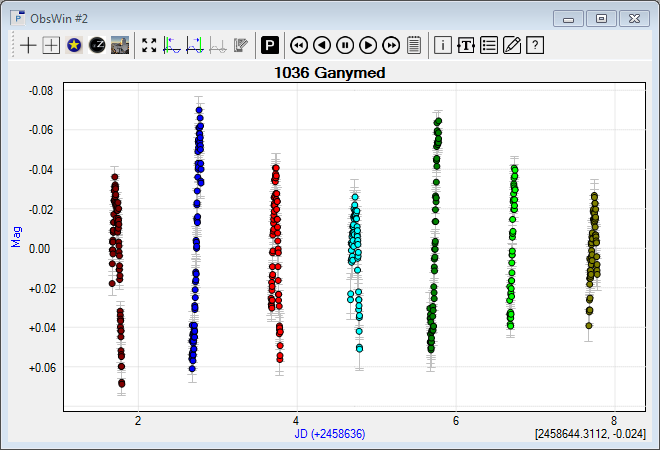- Select Open in the File menu (or click on
 in the main Toolbar) to display the File Open box. Navigate to the Peranso Tutorials 7 folder. To do so, first locate your My Documents folder (typically C:\Users\<your_user_name>\Documents). In there is a subfolder Peranso, then select the subfolder Tutorials. Finally, select the folder 7. Determining a minor planet's rotation period using FALCS. Select the file 1036 Ganymed and click the Open button. in the main Toolbar) to display the File Open box. Navigate to the Peranso Tutorials 7 folder. To do so, first locate your My Documents folder (typically C:\Users\<your_user_name>\Documents). In there is a subfolder Peranso, then select the subfolder Tutorials. Finally, select the folder 7. Determining a minor planet's rotation period using FALCS. Select the file 1036 Ganymed and click the Open button.
- This loads the contents of the file and creates an Observations Window (ObsWin) with caption "1036 Ganymed", showing 429 active observations obtained over a range of 6.107 days, and spread over 7 Observation sets. Each set contains the observations of one night.
Note also that each observation has an associated brightness (magnitude) error value. Brightness error values are taken into account when performing a period analysis using the FALC method.

- The proper alignment of Observation Sets (ObsSets) is critical to finding the right period, since the FALC method can find a different period for different ObsSet alignments. In many cases, you will have to align ObsSets so that they mesh well together, before you start the period analysis.
The alignment is not always mandatory, and very much depends on the particular characteristics of the observations (e.g., usage of filters, similarities between observing instruments, evolution of light curve over time, etc.). In this tutorial example, the peaks of the ObsSets have different magnitude values, so we expect that an adjustment will be needed.
By aligning an ObsSet, you move it up or down in relation to the other ObsSets in the ObsWin. By doing this, you can get the data for a given ObsSet to line up with the data from other ObsSets. In some cases (for instance, when working with unfiltered differential variable star magnitudes obtained by different observers) this is not very easy.
Peranso offers two ways to assist with the alignment of ObsSets : the Time and Brightness Offset command and the Subtract Avg Brightness command. The first command allows to precisely mesh ObsSets in a graphical way, while the second (simple) command simply subtracts for each Observation set the average brightness from all observations in that Observation set. This is explained in Tutorial 3. Execute the Subtract Avg Brightness command on the ObsWin.

- In previous tutorials (e.g., Tutorial 2) we mentioned that a visual inspection of the light curve is important before you run any period analysis method. Let's do this on the above ObsWin by zooming in on the peaks of the 2nd and 3rd ObsSet. Select one observation near the top of the left peak and one observation near the top of the right peak and roughly measure the distance in Julian days between both. We find a value of approximately 0.97 days or 23.3 hours. You can accomplish the same with the Measurement indicator. Our visual inspection gives us a very rough indication of what might be the rotation period of this asteroid. We will use it in the next section as starting point for a detailed period analysis.
|